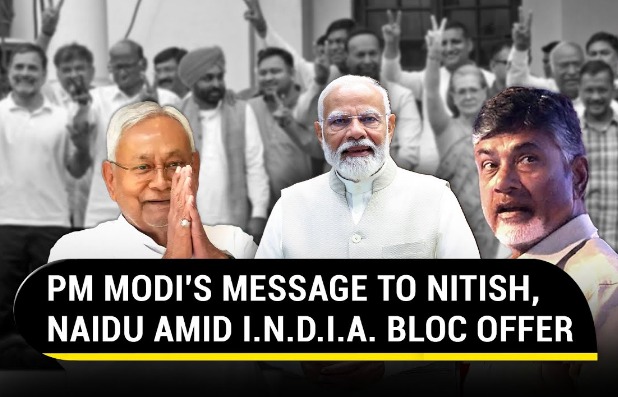A third term for Prime Minister Narendra Modi appears certain with the National Democratic Alliance hovering around the 292 mark as votes for the Lok Sabha polls were counted on Tuesday. But the day belongs to the resurgent opposition, which performed way over the modest expectations raised by exit polls.
Modi will be only the second leader to win a third term after founding prime minister Jawaharlal Nehru and has promised a transformative next five years. The spotlight is now turning on the BJP’s two key allies, N Chandrababu Naidu in Andhra Pradesh and Nitish Kumar in Bihar, who between them have about 30 seats that will enable the NDA to form the next government
The ruling Bharatiya Janata Party was dented in the country’s two biggest states, Uttar Pradesh and Maharashtra. In West Bengal, Mamata Banerjee’s Trinamool Congress seized a victory even though it had initially looked likely to lose heavily.
MODI THANKS VOTERS
Addressing the nation from the BJP’s headquarters in Delhi after it became apparent the party will form the new government, albeit with much-needed support from NDA partners, Prime Minister Narendra Modi thanked voters and said, “Today’s victory (is) a victory of world’s biggest democracy.”
Modi will be only the second leader to win a third term after founding prime minister Jawaharlal Nehru and has promised a transformative next five years. Under him, India has become the world’s fastest-growing major economy and he has said he wants to make it the world’s third largest in three years, behind the United States and China.
THE ‘KINGMAKERS’
The spotlight is now turning on the BJP’s two key allies, N Chandrababu Naidu in Andhra Pradesh and Nitish Kumar in Bihar, who between them have about 30 seats that will enable the NDA to form the next government.
Both Kumar and Naidu had been part of the opposition, walking out of the NDA over various issues.
UP, MAHARASHTRA KEY FACTORS
The BJP’s biggest reverses came in Uttar Pradesh and Maharashtra. In Uttar Pradesh, the Samajwadi Party (SP) pulled off a stunning performance. The biggest star of the day could well be Akhilesh Yadav, whose SP astounded analysts by winning 36 seats compared to the BJP’s 33. The Congress won seven seats. The exit polls had predicted that the BJP would win almost 70 seats in the state. Mayawati’s BSP crashed out without a single seat and its supporters appeared to have voted tactically and switched to backing the SP.
In Maharashtra, the predictions that the BJP would take a heavy hit turned out to be correct. The Maha Vikas Aghadi alliance of the Shiv Sena (UBT), Congress and NCP (SP) has done even better than expected.
BIG BATTLES
Several celebrity politicians faced bitter battles during the election and in Amethi, union minister Smriti Irani, who defeated Rahul Gandhi five years ago, crashed to defeat against Gandhi family loyalist Kishori Lal Sharma. In Thiruvananthapuram, Shashi Tharoor defeated the BJP’s Rajiv Chandrasekhar in a fierce three-way contest. Tharoor finally surged ahead when coastal voters swung in his favour.
Actor Suresh Gopi was the BJP’s first winner ever in Thrissur, Kerala. Here too the Congress was defeated in a three-cornered fight.
Rahul Gandhi won in both his constituencies, Wayanad in Kerala and Raebareli in Uttar Pradesh where he romped home by a huge 3.88 lakh votes. Asked at a press conference which constituency he would resign from he admitted openly that he hadn’t decided.
“The country has unanimously and clearly stated, we do not want Narendra Modi and Amit Shah to be involved in the running of this country, we do not like the way they have run this country,” Gandhi told reporters. “That is a huge message.”
But in terms of pure numbers, the biggest winner of the day may have been former Madhya Pradesh chief minister Shivraj Singh Chauhan who displayed his strong hold on the state by winning his election by over 8 lakh. Prime Minister Modi won in Varanasi by 1.5 lakh votes, down from a margin of 4.79 lakh votes in 2019.
WHAT IT MEANS FOR MARKETS AND POLICYMAKING
The poll outcome spooked investors, with stocks falling steeply as emerging results showed that Modi would, for the first time since sweeping to power in 2014, depend on regional parties whose political loyalties have wavered over the years.
Analysts say this could introduce some uncertainty into policymaking after a decade in which Modi has ruled with an authoritative hold.
LOK SABHA CAMPAIGN RECAP
PM Modi began his re-election campaign by focusing on his achievements over the last 10 years but later switched to mostly targeting the Congress by accusing it of favouring certain communities and sections, which the opposition party denies.
The opposition largely campaigned on affirmative action programmes and saving the Constitution from what they call Modi’s “dictatorial rule”, an allegation refuted by the BJP.
Unemployment and inflation were also among key concerns for voters, surveys have said.
SEVEN-PHASE SAGA
The elections saw about 642 million voters casting their ballots in the seven phases. This despite some election phases spanning over the scorching summer days in May and June. A record 312 million women also participated in the voting process, the Election Commission said.
Votes were cast at more than 1 million polling stations, with big states like Uttar Pradesh, West Bengal, and Bihar going to the polls in each of the seven phases.
According to the country’s first-past-the-post multiparty electoral system, a party or coalition must breach the mark of 272 seats to secure a majority.




